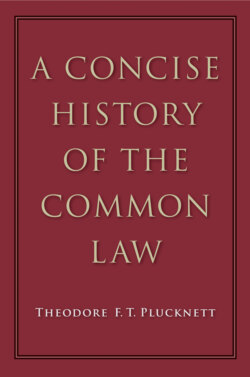Читать книгу A Concise History of the Common Law - Theodore F. T. Plucknett - Страница 106
На сайте Литреса книга снята с продажи.
5. Ancient modes of trial THE ORDEALS
ОглавлениеAn attentive study of this document will show the difficulties which confronted the government in the administration of criminal justice. The presenting jury from every hundred would very soon provide the royal officers with a goodly number of suspicious characters. But suspicion is not proof, and the presentment by the hundred, like its modern descendant, indictment by grand jury, is merely an accusation and not a conviction. Having found the suspects, how is the question of their guilt or innocence to be determined? The document we have just quoted mentions two methods, “making one’s law” and “going to the water”. We must now for a moment describe these and one or two other methods of trial then in use, for it was the limitations and uncertainties of the ancient methods which led to the development of the modern petty jury.
The most ancient of these was the ordeal, which took a variety of different forms. Its origin must date from before the introduction of Christianity, but the practice was so deep-rooted that the Church, in this as in other cases, felt bound to adopt it. In consequence we find the ordeal surrounded by Christian ceremonies which must, no doubt, have added considerably to its moral effectiveness—and perhaps even to its practical value as a psychological test of truth-telling. Of the several forms of ordeal in use the ordeal of hot iron was that most common for freemen. It was administered at the most solemn moment of the Mass; a special ritual was prescribed in the old service books telling us how the heated iron was to be carried by the accused over a distance of nine feet; then—
“the hand was sealed and kept under seal for three nights and afterwards the bandages removed. If it is clean, God be praised; but if unhealthy matter is found where the iron was held he shall be deemed guilty and unclean.”1
Another variant was the ordeal of boiling water, where the accused had to plunge his hand into a bowl of boiling water and take out a stone; his guilt or innocence was ascertained by inspecting his hand after three days. The ordeal of cold water was more often applied to the unfree. The accused was solemnly exhorted by the priest during Mass to confess his guilt if he were guilty; if he persisted in maintaining his innocence then—
“let the hands of the accused be bound together under the bent knees after the manner of a man who is playing the game of Champ-estroit. Then he shall be bound around the loins with a rope strong enough to hold him; and in the rope will be made a knot at the distance of the length of his hair; and so he shall be let down gently into the water so as not to make a splash. If he sinks down to the knot he shall be drawn up saved; otherwise let him be adjudged a guilty man by the spectators.”2
Still another variety of ordeal was that of the cursed morsel, which was used only for the trial of clergy. This consisted in making the accused swallow a piece of food in which was concealed a feather or such like; if he was successful, he was innocent, but if he choked he was guilty. Although the Church adopted the ordeals which it found in use among the populace, some of the more critical clergy had misgivings. Then also there was obviously the possibility of the priest manipulating the ordeal, and Peter the Chanter, a celebrated theologian of the university of Paris (ob. 1197), suggests that he had some sort of moral responsibility for the rightness of the result.1 Its abolition was rendered all the more difficult by the system of fees which grew up around it—always a powerful obstruction in the way of reform. A particular church, like St. Peter’s, Northampton, might have a monopoly of the proceedings;2 elsewhere, the archdeacon might be entitled to dues—as at Coventry where he received thirty pence for each ordeal.3
In the great majority of cases the ordeal was the accused’s mode of defence; yet on rare occasions we may find a prosecutor offering to undergo an ordeal himself in proof of his accusation,4 and in two cases of 1202 the accused was given the choice of bearing the iron himself or of letting the accuser do it—and naturally elected the latter procedure.5 Countless varieties of ordeal are still in use in different parts of the world among primitive tribes.6
